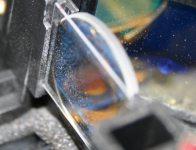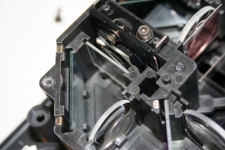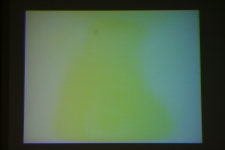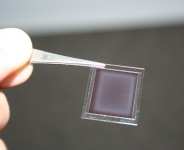Why is my projector dim?
When your projector was first installed, you will recall a bright image which could easily be viewed in daylight. Today, perhaps three years on, you have accepted that you can only see the image on a dull day with the blinds drawn. Here's why, and what you can do about it:
1. Dust ingress into the optical engine
The dust filters on projectors are unable to prevent the ingress of microscopically fine dust, especially with LCD projectors. This dust forms a stubborn film on each optical surface within the optical engine, and it cannot be removed with conventional on-site servicing methods. Typically, there are 40 optical surfaces inside the engine, and if each of these has a transmission or reflectivity reduction of 2%, only 44% of the original light output will reach your projection surface. The optical engine is a sealed unit buried within the projector, and is inaccessible without specialist knowledge and equipment.
Solution - Order a professional laboratory optics-cleanse: This is a specialist service, requiring electrostatic discharge protection, a clean-room, ultrasonic cleaning facilities, and trained technicians. We have these facilities at our Projector Clinic, and offer overnight, weekend and holiday service options.


Dust film on one optical surface Exposed: A section of the complex optical engine
2. Ageing lamp
Most projectors use metal halide lamps whose output diminishes over time. Typically the light output of the lamp will be between 25% and 50% less towards the end of its rated life.
Solution 1 - Replace the lamp: The best option if you have a ready supply of spare lamps and have used same-model projectors throughout your school. However, if this is a lone projector, you risk buying an expensive new lamp that may out-live the projector.
Solution 2 - Replace the projector: If the projector is very long-in the tooth, or has sustained heat damage, projector replacement is the most economical solution. You will inevitably find that there is not a direct replacement available for your original projector, and there are numerous factors that can trip you up if you try to replace it yourself (different zoom ratio, lens on different side, different mounting points, different electrical connector, etc). The best course of action is to ask us for help so that we can find the most economical and risk-free replacement.
3. Overheated lamp
How many times have you witnessed someone cancel the 'filter clean' warning and carry-on? Of course, we've all done it when the pressure is on. Repeatedly ignoring the filter warning means the filter will become progressively less able to inhale cool air, which exponentially increases the lens temperature. You'll experience a very accelerated the premature ageing of the lamp, and therefore deterioration in light output.
Solution 1 - Replace the lamp: The best option if the projector is mid-life and has not sustained any other permanent damage through excess heat.
Solution 2 - Replace the projector: If the projector has sustained other heat-related damage, replacement is likely to be the most cost-effective solution. There may be a direct replacement of the projector available, in which case, you can do this yourself if you wish. Beware of end-of-life models though, because they may provide false economy when it comes to a subsequent lamp replacement. If you wish to replace it with a different model, the best course of action is to call us, so that we can advise you on the best option for replacement.
4. Overheated LCD module
A dirty filter on a projector being used for hours at a time can result in any of the three LCD panels operating at elevated temperatures, resulting in a permanent distortion in the crystal lattice. This is characterised by a permanent and visible 'stain' on the projected image. In extreme cases, we have seen an LCD panel become warped to the extent that one of the projected colours becomes misaligned from the other two.

Stain and misalignment caused by heat-damaged LCD panel
5. Light-damaged optics
The HID lamp in a projector emits UV light, most of which is filtered at an early stage in the light path. Small amounts leak through these filters and effectively sunburn the polarising filters. This is a slow process and happens over a long period of time. The effect is increased opacity of the polarising filters, resulting in less light passing through to the projector surface. Whist this is not fatal to the projector's function, it is an incurable condition and should be taken into consideration when assessing the viability of investing in re-furbishing very old projectors.

Polarizing filter burned by UV light
Conclusion
We understand that there are a lot of variables above, and a lot of options to choose from. We offer a free survey service, where we will come to your school, and conduct a survey of the status of each projector in your school. We record the light output, the legibility, the lamp and projector hours (if available), and any obvious defects. We also note the model of each projector, and the type of mount. From this, we will give you a comprehensive report and recommended action-plan which will help you to schedule remedial work and to budget.
Call us on 0844 414 2802 to arrange a visit to your school.
When your projector was first installed, you will recall a bright image which could easily be viewed in daylight. Today, perhaps three years on, you have accepted that you can only see the image on a dull day with the blinds drawn. Here's why, and what you can do about it:
1. Dust ingress into the optical engine
The dust filters on projectors are unable to prevent the ingress of microscopically fine dust, especially with LCD projectors. This dust forms a stubborn film on each optical surface within the optical engine, and it cannot be removed with conventional on-site servicing methods. Typically, there are 40 optical surfaces inside the engine, and if each of these has a transmission or reflectivity reduction of 2%, only 44% of the original light output will reach your projection surface. The optical engine is a sealed unit buried within the projector, and is inaccessible without specialist knowledge and equipment.
Solution - Order a professional laboratory optics-cleanse: This is a specialist service, requiring electrostatic discharge protection, a clean-room, ultrasonic cleaning facilities, and trained technicians. We have these facilities at our Projector Clinic, and offer overnight, weekend and holiday service options.


Dust film on one optical surface Exposed: A section of the complex optical engine
2. Ageing lamp
Most projectors use metal halide lamps whose output diminishes over time. Typically the light output of the lamp will be between 25% and 50% less towards the end of its rated life.
Solution 1 - Replace the lamp: The best option if you have a ready supply of spare lamps and have used same-model projectors throughout your school. However, if this is a lone projector, you risk buying an expensive new lamp that may out-live the projector.
Solution 2 - Replace the projector: If the projector is very long-in the tooth, or has sustained heat damage, projector replacement is the most economical solution. You will inevitably find that there is not a direct replacement available for your original projector, and there are numerous factors that can trip you up if you try to replace it yourself (different zoom ratio, lens on different side, different mounting points, different electrical connector, etc). The best course of action is to ask us for help so that we can find the most economical and risk-free replacement.
3. Overheated lamp
How many times have you witnessed someone cancel the 'filter clean' warning and carry-on? Of course, we've all done it when the pressure is on. Repeatedly ignoring the filter warning means the filter will become progressively less able to inhale cool air, which exponentially increases the lens temperature. You'll experience a very accelerated the premature ageing of the lamp, and therefore deterioration in light output.
Solution 1 - Replace the lamp: The best option if the projector is mid-life and has not sustained any other permanent damage through excess heat.
Solution 2 - Replace the projector: If the projector has sustained other heat-related damage, replacement is likely to be the most cost-effective solution. There may be a direct replacement of the projector available, in which case, you can do this yourself if you wish. Beware of end-of-life models though, because they may provide false economy when it comes to a subsequent lamp replacement. If you wish to replace it with a different model, the best course of action is to call us, so that we can advise you on the best option for replacement.
4. Overheated LCD module
A dirty filter on a projector being used for hours at a time can result in any of the three LCD panels operating at elevated temperatures, resulting in a permanent distortion in the crystal lattice. This is characterised by a permanent and visible 'stain' on the projected image. In extreme cases, we have seen an LCD panel become warped to the extent that one of the projected colours becomes misaligned from the other two.

Stain and misalignment caused by heat-damaged LCD panel
5. Light-damaged optics
The HID lamp in a projector emits UV light, most of which is filtered at an early stage in the light path. Small amounts leak through these filters and effectively sunburn the polarising filters. This is a slow process and happens over a long period of time. The effect is increased opacity of the polarising filters, resulting in less light passing through to the projector surface. Whist this is not fatal to the projector's function, it is an incurable condition and should be taken into consideration when assessing the viability of investing in re-furbishing very old projectors.

Polarizing filter burned by UV light
Conclusion
We understand that there are a lot of variables above, and a lot of options to choose from. We offer a free survey service, where we will come to your school, and conduct a survey of the status of each projector in your school. We record the light output, the legibility, the lamp and projector hours (if available), and any obvious defects. We also note the model of each projector, and the type of mount. From this, we will give you a comprehensive report and recommended action-plan which will help you to schedule remedial work and to budget.
Call us on 0844 414 2802 to arrange a visit to your school.


